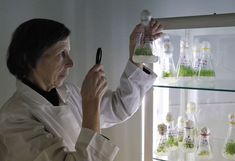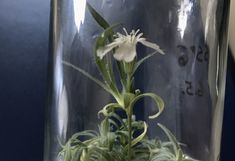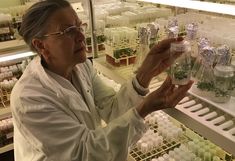Flowering Silene
32,000 year old plant blooms for the first time in vitro
Perceiving the dimension of time is a special challenge for human imagination. When it comes to plants, we only think of a few thousand years of domestication of our crops, which may have begun since people became sedentary. For example, the oldest finds for sedentary cultures in Austria come from Brunn near Vienna and date back to 5,500 BC. BC back.
In 2012, Dr. Svetlana Yashina and her colleagues from the Russian Academy of Sciences in Pushchino with their groundbreaking work in the fields of cryobiology, cell biology and botany, revived plants from 32,000 year old seeds of unknown species from the Siberian permafrost.
Dr. Svetlana Yashina looking at her revitalized Silene plants in tissue culture.
|
The plants originally identified as Silene stenophylla were regenerated from the placenta using in vitro tissue culture. The plants revitalized in this way bloomed and gave seeds that germinated successfully (Yashina et al., 2012). Seen in this way, the revitalization of a plant that last bloomed, when woolly mammoths roamed the plains, revived something that was already extinct.
The work had a significant resonance both in Russia and abroad, which was reflected in the headlines of the world news agencies (CNN: life revived from prehistoric seeds; CBS: Russian scientists; germinating ice age seeds; NATURE: wildflower blooms on ice after 30,000 years; BBC: Old plants come back to life after 30,000 frozen years).
This plant has also caught the interest of artists and was presented at the Plant Biotechnology Unit of BOKU (PBU) to a wider public at the Fascination of Plant Day in Vienna in 2019.
To enable the art exhibition "Aeviternity" by Christian Kosmas Mayer (February – June 2019) in the Mumok, Museum of Modern Art, Vienna 2019, the Plant Biotechnology Unit of BOKU managed to get in touch with the Russian colleagues at the Institute of Cell Biophysics, Russian Academy of Sciences, Pushchino, and to receive specimen of the revitalized Silene on the one hand as a loan for the exhibition, but on the other hand as research objects.
It is therefore absolutely important to me to have real copies of the old Silene stenophylla in the exhibition. With their presence, they enable visitors to feel something physical that goes beyond what can be said or understood. I think that is where art can really be important: the connection between knowledge and intuition, mind and feeling. Christian Kosmas Mayer |
Conservation was ensured through regular subcultivation by Veronika Hanzer from the PBU. Now the plant thanked us and flowered in vitro for the first time.
As the Austro-American Nobel Prize winner Eric R. Kandel rightly states in The Age of Insight (2012), the constant dialogue between art and science has its origins in Fin de Siècle Vienna in the 19th century. Since then, art and science have influenced each other. It is the challenge for active scientists and artists to ensure that in the future these interdisciplinary influences could enrich our knowledge and enjoyment of science and art.





